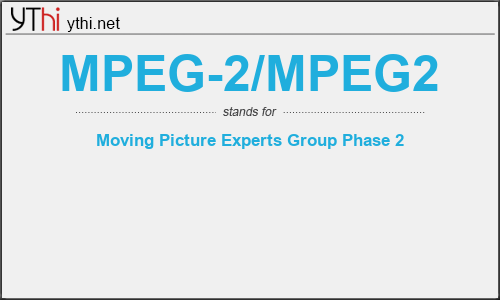What does MPEG-2/MPEG2 mean? What is the full form of MPEG-2/MPEG2?
The full form of MPEG-2 is Moving Picture Experts Group Phase 2
Moving Picture Experts Group Phase 2(MPEG-2) (a.k.a. H.222/H.262 as was defined by the ITU) is a standard for “the generic coding of moving pictures and associated audio information”.[1] It describes a combination of lossy video compression and lossy audio data compression methods, which permit storage and transmission of movies using currently available storage media and transmission bandwidth. While MPEG-2 is not as efficient as newer standards such as H.264/AVC and H.265/HEVC, backwards compatibility with existing hardware and software means it is still widely used, for example in over-the-air digital television broadcasting and in the DVD-Video standard.
The ISO/IEC approval process was completed in November 1994. The first edition was approved in July 1995 and published by ITU-T and ISO/IEC in 1996. Didier LeGall of Bellcore chaired the development of the standard and Sakae Okubo of NTT was the ITU-T coordinator and chaired the agreements on its requirements.
The technology was developed with contributions from a number of companies. Hyundai Electronics (now SK Hynix) developed the first MPEG-2 SAVI (System/Audio/Video) decoder in 1995.
The majority of patents that were later asserted in a patent pool to be essential for implementing the standard came from three companies: Sony (311 patents), Thomson (198 patents) and Mitsubishi Electric (119 patents).
In 1996, it was extended by two amendments to include the registration of copyright identifiers and the 4:2:2 Profile. ITU-T published these amendments in 1996 and ISO in 1997.
There are also other amendments published later by ITU-T and ISO. The most recent edition of the standard was published in 2013 and incorporates all prior amendments.
MPEG-2/MPEG2
means
Moving Picture Experts Group Phase 2![]()
Translate Moving Picture Experts Group Phase 2 to other language.


Leave a Reply
You must be logged in to post a comment.